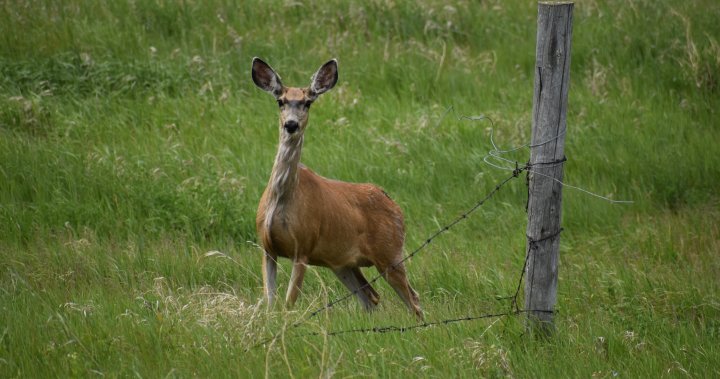Chronic wasting disease, a condition that fatally infects the brains of animals like deer, continues to spread in Canada and has been found for the first time in a new province.
The B.C. government announced on Thursday it had detected two cases of the disease in deer south of Cranbrook. Scientists already spotted it in 34 U.S. states and four other provinces.
The disease is highly contagious and affects members of the cervid family, like moose and elk, infecting their brains. Symptoms range from severe weight loss to paralysis and pneumonia, and result in the animals being separated from others in the herd.
It is always fatal and there is no vaccine or treatment.
“(The discovery in B.C.) is very concerning,” University of Calgary veterinary professor Sabine Gilch said, “because usually if there are two animals that are detected, then there will be more.”
Researchers said the spread is worrying because it represents a threat to deer and elk populations and because the more it spreads, the more chances it has to spread to other animals.
They told Global News that research indicates it is unlikely CWD could jump to humans. But given that there are no vaccines or treatments, the possibility of human infection is unsettling.
A map from the United States Geological Survey shows Chronic Wasting Disease detections prior to Thursday’s discovery in B.C.
United States Geological Survey
What is chronic wasting disease?
Chronic wasting disease is caused by prions — a misshapen version of normally-occurring proteins in the brain.
That’s part of the problem, Gilch said, since the body “does not recognize the prions as a foreign protein as it would recognize viruses or bacteria,” so there is no immune response.
Get the latest Health IQ news.
Sent to your email, every week.
Creutzfeldt-Jakob disease and bovine spongiform encephalopathy (BSE), which causes mad cow disease, are also caused by prions.
Another issue is that chronic wasting disease causes increased drool and urination and that infected animals excrete prions through saliva and urine.
Prions can bind to soil, giving another creature a chance to ingest them when they eat vegetation and can, even years later, catch the disease.
“The problem we have in many areas now is that the prevalence is so high, the environment is probably so contaminated that there’s no easy solutions right now,” University of Alberta researcher Debbie McKenzie said.
“We have areas in the South Saskatchewan River valley where greater than 50 per cent of the male deer bucks are positive. So, in essence, every other male is positive,” the professor told Global News.
Infected animals can look healthy, she said, adding that white-tailed deer can live up to two years on average with chronic wasting disease. But that limits their breeding seasons, meaning they’re not making more healthy deer to replace the infected and dead ones.
Experts said herds with chronic wasting disease have significantly smaller populations than those without it. And they said the disease will likely continue killing more animals.
They fear it could jump to caribou, which are already endangered.
Unlike mad cow disease, sick deer cannot be culled because they are not domesticated.
“(CWD is) already in the wilderness, which is not controllable,” said Dr. Surachai Supattapone, chair of the Department of Microbiology and Immunology at Dartmouth’s Geisel School of Medicine.
“You can imagine, out there in the wild now, in the soil, lots of little animals like mice and beavers and bears could pick up this disease,” he said, speaking from Hanover, New Hampshire.
“All the current studies suggests that CWD, in its current states is not highly likely to jump across species barriers into human and livestock that we commonly eat,” Suttapattapone told Global News.
But it’s so widespread in Western Canada, McKenzie cautioned, some people may be shortening the connection.
“The number of people who are potentially eating infected animals is increasing,” she said. “Whether that translates into a case, I don’t know because… we don’t have a value for the risk. So it’s possible, but we haven’t seen it yet.”
She urged all hunters to always test their deer and elk.
Canadian law requires all infected animals or those with suspected infections to be reported to a regional Canadian Food Inspection Agency veterinarian.
It also requires chronic wasting disease testing for all farmed cervids older than one year slaughtered in Saskatchewan, Alberta, Yukon, Manitoba, Ontario and Quebec.
The disease was discovered in 1967 in the U.S, and its continued spread since then shows that efforts to contain it are failing, Supattapone said.
“I hope British Columbia has the resources to do good surveillance on the disease to learn how it spreads… and also to support hunters and get their deer tested,” Gilch said.
“Even if there’s no demonstrated transmission to humans, there is the concern.”
© 2024 Global News, a division of Corus Entertainment Inc.










